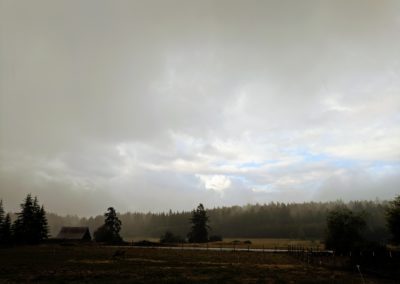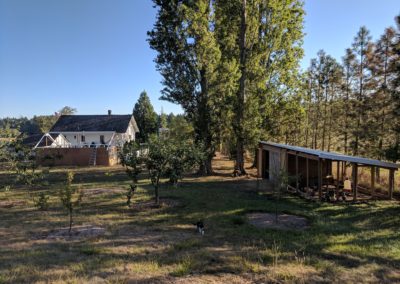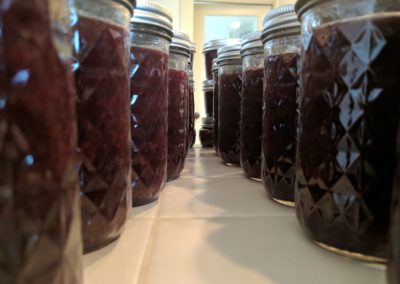Fall is most certainly in the air. There is a chill in our house this morning which has not been present in over a month. Fog hovers above the pasture and slowly dissipates as the sun rises. There are accents of green sparsely scattered across the fields after last week’s rain.
Autumn highlights a changing rhythm. Visitors become less of a fixture in downtown, school buses resume their morning and afternoon routes, and islanders begin to mingle about the cafés and parks again.
The work of harvest must commence in earnest. With harvest comes food preservation and storage. Each year our production increases; nuts multiply in quantity, fruit grows heavier on the limbs, and vegetables build in their abundance.
Fall encourages one last push before winter break. On the list of activities are the garden and the White Greenhouse project. Yesterday I erected the first of eight sets of rafters. Tomorrow I will place the ridge beam. The project is nearing completion.
On Monday I culled the roosters and one hen. Days prior I had been losing all of my eggs to an offending chicken who went about the coop as each hen laid her egg eating the prize she just deposited. One by one, I isolated three hens and a rooster. Immediately my egg count resumed.
Monday’s culling was two-fold: 1.) I had too many roosters as a result of incubation and 2.) I needed to eliminate the egg robbers from my flock. I hate to butcher such young birds in the peak of their production, but the problem was far too great not too.
Rather than butcher all three hens I dispatched the most likely candidate first and tied a cotton string around the ankles of the other two and set them loose in the coop once more. [Update]: The chicken egg consumption resumed almost immediately. I’ve removed the offenders, and eggs counts are back up. I will butcher these two hens the first chance I get.
Save Water with the Best Drip System Design for Market Gardens and Row Crops
Find out the most effective way to grow food in your garden with uniform rows and inexpensive drip irrigation.
How to Thresh Grain In San Juan County, WA
Rye was carried to the Americas by British and Dutch settlers. Today, rye is now harder and harder to find as American’s have generally lost the taste for this hardy cereal, today preferring a lot more ready-made whole wheat grains in abundance on market cabinets. This post describes rye’s history and the practice of grain threshing.
Free Drip Irrigation System for Distant Unestablished Chestnut Trees
Many nut trees and shrubs are incredibly drought tolerant after they mature. However, the first four to five years they might need a good amount of hydration to get proven with vast root systems. Utilize this technique to gradually deep water your brand-new trees with no need for costly and labor-intensive drip irrigation systems.
Food Forests: Learning About Natural Forest Guilds
From the Olympic National Forest we find ourselves learning about creation and the naturally occurring forest guilds along with their natural progression towards sustainable self reliance.









